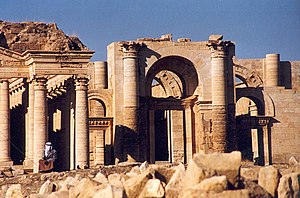This is an old revision of this page, as edited by PericlesofAthens (talk | contribs) at 02:39, 17 February 2011 (Undid revision 414247690 by 98.228.100.185 (talk)). The present address (URL) is a permanent link to this revision, which may differ significantly from the current revision.
Revision as of 02:39, 17 February 2011 by PericlesofAthens (talk | contribs) (Undid revision 414247690 by 98.228.100.185 (talk))(diff) ← Previous revision | Latest revision (diff) | Newer revision → (diff)35°35′17″N 42°43′06″E / 35.58806°N 42.71833°E / 35.58806; 42.71833
UNESCO World Heritage Site| UNESCO World Heritage Site | |
|---|---|
 | |
| Criteria | Cultural: ii, iii, iv, vi |
| Reference | 277 |
| Inscription | 1985 (9th Session) |
Hatra (Template:Lang-ar al-Ḥaḍr) is an ancient city in the Ninawa Governorate and al-Jazira region of Iraq. It is currently known as al-Hadr, a name which appears once in ancient inscriptions, and it in the ancient Iranian province of Khvarvaran. The city lies 290 km (180 miles) northwest of Baghdad and 110 km (68 miles) southwest of Mosul.
History

Hatra was a mixed Mesopotamian/Assyrian and Arab city founded by Ancient Arab tribes some time in the 3rd century BCE. A religious and trading centre under the Parthian empire of Iran, it flourished during the 1st and 2nd centuries BCE. Later on, the city became the capital of possibly the first Arab Kingdom in the chain of Arab cities running from Hatra, in the northeast, via Baalbek and Petra, in the southwest. The region controlled from Hatra was the Kingdom of Araba, a semi-autonomous buffer kingdom on the western limits of the Parthian Empire of Iran, governed by Arabian princes.
Hatra became an important fortified frontier city and withstood repeated attacks by the Roman Empire, and played an important role in the Second Parthian War. It repulsed the sieges of both Trajan (116/117) and Septimius Severus (198/199). Hatra defeated the Iranians at the battle of Shahrazoor in 238, but fell to the Iranian Sassanid Empire of Shapur I in 241 and was destroyed. The traditional stories of the fall of Hatra tell of an-Nadira, daughter of the King of Araba, who betrayed the city into the hands of Shapur. The story tells of how Shapur killed the king and married an-Nadira, but later had her killed also.
Hatra is the best preserved and most informative example of a Parthian city. It is encircled by inner and outer walls nearly 4 miles (6.4 km) in circumference and supported by more than 160 towers. A temenos surrounds the principal sacred buildings in the city’s centre. The temples cover some 1.2 hectares and are dominated by the Great Temple, an enormous structure with vaults and columns that once rose to 30 metres. The city was famed for its fusion of Greek, Mesopotamian, Assyrian and Arabian pantheons, known in Aramaic as Beiṯ Ĕlāhā ("House of God"). The city had temples to Nergal (Assyrian and Akkadian), Hermes (Greek), Atargatis (Syro-Aramaean), Allat and Shamiyyah (Arabian) and Shamash (the Assyrian sun god). Other deities mentioned in the Hatran Aramaic inscriptions is the Aramaean Ba'al Shamayn, and the Assyrian female deity known as Ashurbel, which latter is perhaps the assimilation of the two deities Ashur and Bel, despite their being individually masculine.
List of rulers
In inscriptions found at Hatra, several rulers are mentioned. Other rulers are sporadically mentioned by classical authors. They appear with two titles. The earlier rulers are called mrj´ (translation uncertain), the later ones mlk -king.
| Name | title | years attested | Comments |
|---|---|---|---|
| Worod | mrj´ | ||
| Ma’nu | mrj´ | ||
| Elkud | mrj´ | AD 155/156 | |
| Nashrihab | mrj´ | AD 128/29 - 137/38 | |
| Nashru | mrj´ | 128/29 - 176/77 | |
| Wolgash I | mrj´ and mlk - King | ||
| Sanatruq I | mrj´ and mlk - King | AD 176/177 | ruled together with Wolgash I |
| Wolgash (II?), son of Wolgash (I.) | |||
| Abdsamiya | mlk - King | AD 192/93 - 201/202 | Supported the Roman emperor Pescennius Niger |
| Sanatruq II | mlk - King | AD 207/08 - 229/230 |
Modern Hatra

Hatra was used as the setting for the opening scene in the 1973 film The Exorcist, and since 1985 is a UNESCO World Heritage Site. The Al Hadr Hotel, located within a kilometer of the Hatra ruins, was the Division HQ for the 101st ABN after the 2003 invasion of Iraq.
See also
References
- Atlas of classical archaeology, Moses I. Finley. pp.239-241
- ^ "Hatra" (Encyclopædia Britannica). Retrieved 2007-01-12.
- ^ Advisory Body Evaluation on Hatra. International Council on Monuments and Sites (ICOMOS). 1985. pages 1-2.
External links
- http://lexicorient.com/e.o/hathra.htm
- http://www.britannica.com/eb/article-9039509
- http://shezaf.net/english/Video/Video/Hatra.html
| World Heritage Sites in Iraq | ||
|---|---|---|
